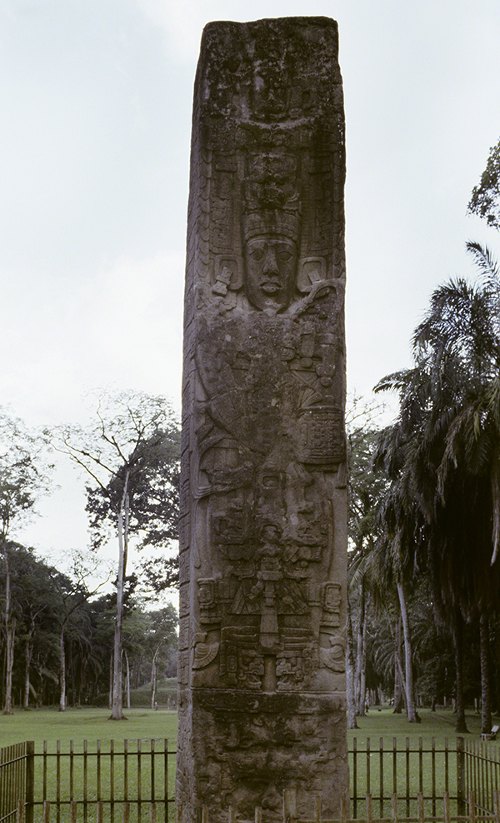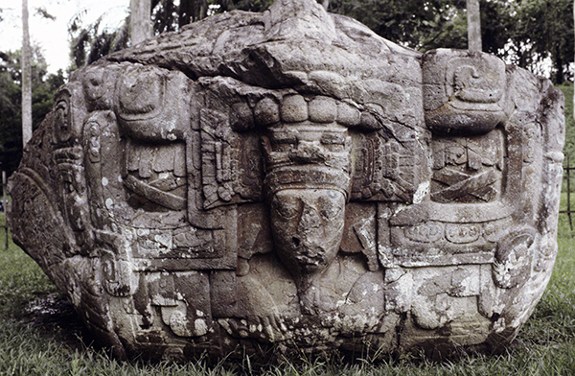Hispanic Heritage Month: Quiriguá
National Hispanic Heritage Month (September 15th to October 15th) has started. I would like to kick off the month-long celebration with one of the most spectacular cultures of Mesoamerica, the Maya. At their zenith, the Maya had a sophisticated culture excelling in the arts, astronomy, mathematics, and engineering that equaled the ancient cultures of the Western world and Asia. Quiriguá in Guatemala was a great Mayan city.
 |
| Maya Culture, Stele E (Monument 5), from Quiriguá, Guatemala, 771 CE. Sandstone, height: 35' (10.7 meters). Image © 2024 Davis Art Images. (8S-21015) |
The sculptors at Quiriguá created the tallest stelae in the Mayan world: Stele E (Monument 5) at a height of 35 feet and Stele F (Monument 6) at a height of 24 feet above ground. The sandstone quarry for these stelae was three miles away. It was a major feat of engineering to extract and move the sandstone to the ceremonial center. The subject matter of the stelae at Quiriguá is the same as those at the Maya city of Copán in Honduras—a standing ruler dominates one or both sides with descriptive glyphs of the ruler's reign filling in the remaining space. Attitude and costume are much the same.
Stele E is dedicated to K'ak Tiliw Chan Yopaat (also known as Cauac Sky, 686–784/785 CE), who ruled for more than 50 years. He was responsible for expanding the ceremonial center and adding monuments to the Great Plaza of Quiriguá. The ceremonial center of Quiriguá—located near Rio Motagua that runs parallel to the northern border between Guatemala and Honduras—is not large. It is 35 miles from Copán, which at one time ruled Quiriguá as a vassal (tribute-paying) state.
The stele contains near identical portraits of K'ak Tiliw Chan Yopaat on the front (north) and rear (south) sides. Typical of the stelae at Quiriguá, the figure of K'ak Tiliw Chan Yopaat is dwarfed by a tall headdress. The glyphs on the west side of the stele commemorate his inauguration in 724 CE and include the title "provincial manager (batab) in the territory of Eighteen Rabbit of Copán," indicating that, at the time, Quiriguá was still a subjugated territory of Copán. The text goes on to relate events of K'ak Tiliw Chan Yopaat’s reign, culminating in his victory over his former overlord in 735 CE.
The Early Preclassic Maya (ca. 1000 BCE–250 CE) occupied Chiapas in Mexico, Honduras, and Guatemala until between 400 and 50 BCE, when they began to spread to the Yucatan Peninsula. After centuries of egalitarian village living, they adapted a hierarchic, autocratic, city-state way of life. Although the reasons for the change are unknown, the platform pyramids, organization of cities, and the rule of warrior-priests represent the influence of Olmec culture and that of another early city-state culture in Teotihuacán.
By the 200s CE, Mayan lands included El Salvador, Honduras, Guatemala, Belize, and Mexico. One of the greatest civilizations of antiquity, the Maya developed a sophisticated society that included development of a very accurate calendar, a complex hieroglyphic script, sophisticated architecture and city planning, water conservation and irrigation techniques, a system of mathematics, and an accurate system of astrometric predictions.
In the Guatemala Highlands, many cities reached their flowering in early Maya civilization, while others reached their apogee (high point) in Postclassic times (ca. 900–1500s CE). Quiriguá was occupied as early as the Late Preclassic Period (ca. 300 BCE–200 CE). The two earliest monuments (referred to as numbers 20 and 21), which date to the late 400s CE, stand near the ceremonial center. Pottery and copper objects found at Quiriguá indicate that the city was still active in Postclassic times, and that the city may have traded with Chichén Itzá, a Mayan city in Mexico. In Late Classic times (600–900 CE), Quiriguá may have controlled the trade in obsidian and jade (found in the riverbed of the Motagua).
 |
| Maya Culture, Zoomorph B (Monument 2), from Quiriguá, Guatemala, 780 CE. Sandstone, width: 14'9" (4.5 meters). Image © 2024 Davis Art Images. (8S-21018) |
After the carving of Stele E, tall monument carving declined and much smaller forms were created. Zoomorphs are deities represented as animals or with animal attributes. These, along with altars, became the most popular monuments commemorating social, religious, scientific, and historical events relating to rulers and society. The zoomorphs resemble crouching creatures, usually with two heads and composite forms combining animals such as frogs, turtles, or jaguars. Glyphs are incorporated as part of the overall design of zoomorphs. These forms probably functioned as mythological or religious entities.
Zoomorph B is one of the most interesting, if not the most complex, monuments at Quiriguá. Dedicated by the ruler K'ak Tiliw Chan Yopaat, it is thought to be one of three zoomorphs that dealt with the Maya creation myth. Although hard to discern among the florid carving and glyphs, Zoomorph B contains aspects of three animals: a snake, a crocodile, and a jaguar. K'ak Tiliw Chan Yopaat emerges out of the jaguar’s mouth. Notice the row of round teeth above his head and rounded ears on either side of the teeth. The shape of the stone as a whole is meant to resemble a turtle's shell. The entire composition equates K'ak Tiliw Chan Yopaat with the First Father (the creator god Itzamna) who was born from a cosmic turtle shell.
Correlations to Davis Programs: Experience Art: Unit 1 Art History; A Community Connection 2E: 1.5; Davis Collections: Ancient Central America

Comments